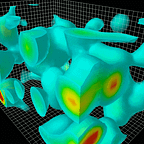Heisenberg’s Uncertainty Principle: Everywhere at Once
Have you ever tried to be at two places at once? If so, probably didn’t work out well.
Believe it or not (all jokes aside), this is actually possible. Heisenberg’s Uncertainty Principle essentially describes how a particle’s position and velocity cannot be exactly predicted. This seemingly useless or rather detached concept — from an ordinary view of the Universe — is actually one of the most significant ones and is present throughout the Universe. The weird thing is that the act of measuring the particle will change the outcome. Before we talk about this prominence of Heisenberg’s Uncertainty Principle in the Universe, we have to understand what it actually means and how it works.
Wave-Particle Duality
Particles and waves are two sides of the same coin. They describe certain aspects of phenomenon, but it can get confusing when you try to put these both together. In short, particles and waves have interchangeable aspects, but they respresent different theories.
Take light for instance: it can be described as a particle — a photon — that contains packets of energy but doesn’t have mass. It can also be described as a wave. If you have ever taken a look at the electromagnetic spectrum, you would have seen that it shows light as a wave with a spectrum of different wavelengths and frequencies.
But how would this relate to this eccentric principle?
This is because Heisenberg’s Uncertainty Principle is evidence that moving objects have both particle and wave characteristics. A particle should only be having a particle nature, but the uncertainty of the location and velocity is a wave property, which means that in reality all particles have wave properties. We just don’t detect in large particles since it is easier to detect in lighter particles like the photon and the electron.
The thought experiment, Schrodinger’s Cat, describes how we cannot know the state of a particle precisely, and the act of measuring the particle will change it’s value.
Schrodinger’s Cat:
Imagine you put a cat in a box with a radioactive atom inside. There is a mechanism that will break open a glass of poison when it detects the decay of the radioactive atom. Before you open the box, we would expect the cat to either be dead or alive, but Schrodinger’s thought experiment shows that the cat is dead and alive. The act of measuring it, or opening the box will change the final result, but before opening it, the cat is dead and alive. Schrodinger proposed this thought experiment to show that superposition shouldn’t make sense to argue against the Copenhagen Interpretation like many other famous scientists like Albert Einstein. The Copenhagen Interpretation stated that quantum particles exist in every possible state simultaneously. At that time, many scientists were not fond of this theory, but the principle seemed to work in describing the weird nature of quantum physics.
Applications
Heisenberg’s Uncertainty Prinicple seems really useless in real life, but we can see its effects if we know where to search.
A particle and an anti-particle can pop into and out of existence since they would merge together and cancel out which maintains the conservation of energy and mass. Since the more we know about the position, the less we do know about the velocity, the particle anti-particle pair stays for fractions of a second popping out of existence. This phenomenon explains many of the Universe’s mysteries. These quantum fluctuations are responsible for space not being empty. There are always a lot of particles popping in and out of existence every single second. A quantum field has a non-zero energy level due to these fluctuations of particle anti-particle pairs.
Casimir Effect
If two neutrally charged plates are kept in a vacuum a few nanometers apart, they will eventually stick together. At first you might think that this is due to Gravity, but the reality is that Gravity isn’t that strong to pull the plates together. This phenomenon cannot be explained by the Electrostatic force since the plates are neutrally charged, so no interaction will occur. The best explanation for this is Heisenberg’s Uncertainty Principle. Since there is more space on the outsides of the plates than in between them, more particle anti-particle pairs will pop into existence on the outsides overpowering the quantum fluctuations in between the plates forcing the plates to move closer together and eventually stick together.
The idea that this quantum principle can have effects in a larger magnitude is amazing. There is another proposed theory that the quantum fluctuations could be the cause that the Universe is expanding more rapidly than ever. This theory is not strongly supported with evidence but is a possibility. We have a lot more to learn about Heisenberg’s Uncertainty Principle and its implications on the Universe.
Thank you for reading this! It really is so exciting to share knowledge about such fascinating topics.
Please subscribe to Learnable where my friends and I create courses in Astronomy, Math, and Computer Science.
